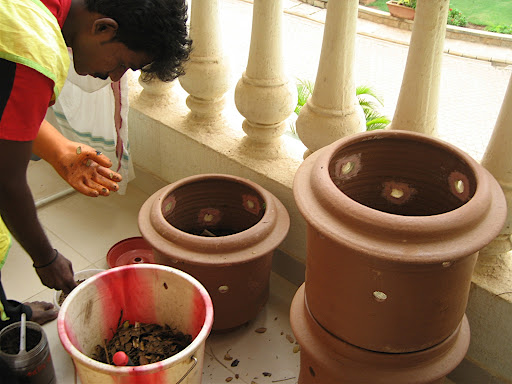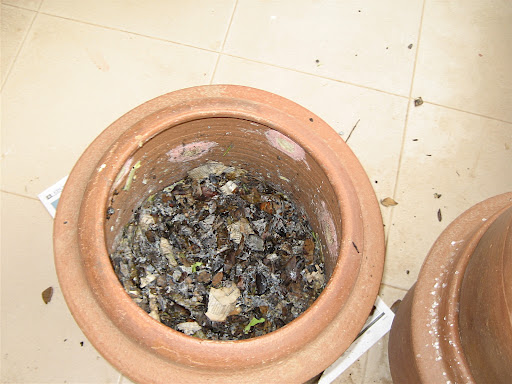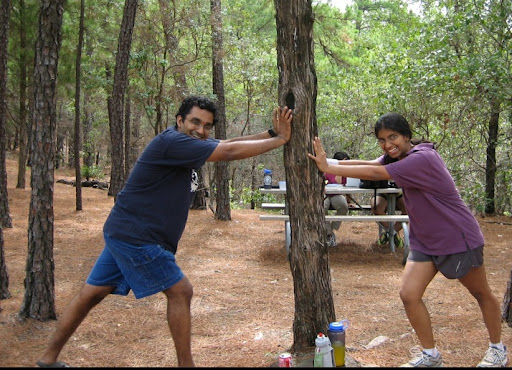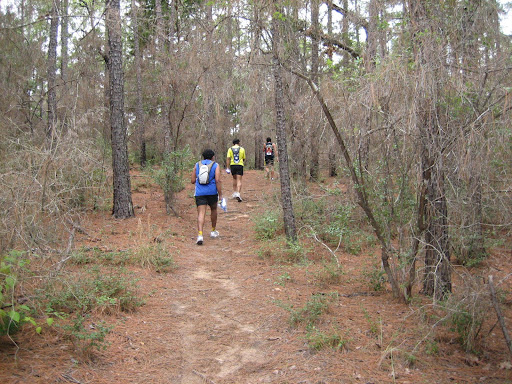I naively assumed that we just feed the mud pots our kitchen waste, add some dry leaves and Eureka, we get compost. For the first few weeks, nothing much happened to the kitchen waste. I added the leaves, the neem powder religiously and the waste just dried up inside. You could see dried onion peels, dried banana peels and so on, not that I gazed into my composter that often! Then suddenly, we decided to eat more fruit and indulged in papaya (never liked it as a kid for it looked like a mango and wasnt - felt cheated). We both started devouring a papaya every other day. The peels and seeds went to the composter and they were promptly covered with dry leaves.
Around this time, Sanjeev's mom was visiting us and I was proudly showing off the composter. She wanted to look in and I enthusiastically decided to add more leaves and turn it around. Little did I know what effect the papaya had had. And then I saw them - white creepy crawlies aka maggots. I freaked out, closed the lid and ran to consult google. My dear composter that had been dry so far was suddenly all wet (thanks to the papaya) and housing these creatures. How did they get there? And what do I do now? Most of the links on google had people as squeamish as I was about maggots. I didnt get much help on what I was to do. One suggestion was to put a slice of cheese and all the maggots will come for it. Then pull out the slice and feed it to the chickens! Great! Where am I going to find these chickens now? I sent a help email to Garima and she told me they get maggots too. That was good to hear but I wanted to know what happens to them. According to google, they are fly larva and will eventually fly away.
Common sense finally prevailed and I called Daily Dump. Poonam came on the phone and asked me if the maggots were white or brown/black. When I told her white, she said they were young ones (well, whatever, I dont want them in my pots)! She was a little amused that I had a maggot crisis. She also told me that they are ok and I should look at all the bacteria that work in my stomach etc. That was soothing...so maybe it was natural. She said someone would come over and fix this. That sort of relaxed me. In the meantime, Sanjeev was enthusiastically turning the waste. He had been wanting to throw in some worms from when we got the composter and was excited to see some life (Too bad I couldnt share the excitement)! A person came the next day and he mixed the kitchen waste with dry leaves, added neem and put it in one of the other empty pots. He said in the initial stage, dry leaves need to be added to counter all the water that comes out. So what we learnt (it took a while to put it in practice)
- add dry leaves regularly
- turn the waste every 2-3 days. Otherwise parts of it, especially in the center, towards the bottom of the pot get very wet. A perfect breeding ground for the maggots (I still dont know how they are born. And no, they dont just come on rotting flesh as some folks told me. We dont eat meat. The maggots just come in our veggie waste)
- as the pot gets about half full, turn it, add more dry leaves if needed and put in a new pot. That way I get to the bottom. Sometimes if you try to turn the waste in the pot, you cant reach all the way to the bottom.
 So, initially it is important to keep it dry. Now after the waste was put in a new pot, I checked it after a week and it was bone dry. There were some black dead maggots (haha, little did I know they were only sleeping. They would soon turn into flies!). I just left it that way. When someone from Daily Dump came for another check, he told told me the pot hadnt composted because it was left dry. So at this stage, it was important to keep it wet. He anyway sieved the dry stuff and there was about a kilo or so of compost. But there was a larger quantity (a nice big fat sack!) of dried waste. I could still see some dried peels and such. I wasn’t very enthusiastic about having bags of dried garbage in my balcony. That’s hardly called compost. He told me that we needed to add water to such dry stuff. I nodded vigorously (as I would do the next time he came for a service and repeated the advice) but did not add any water - the composter should know what needs to be done no?
So, initially it is important to keep it dry. Now after the waste was put in a new pot, I checked it after a week and it was bone dry. There were some black dead maggots (haha, little did I know they were only sleeping. They would soon turn into flies!). I just left it that way. When someone from Daily Dump came for another check, he told told me the pot hadnt composted because it was left dry. So at this stage, it was important to keep it wet. He anyway sieved the dry stuff and there was about a kilo or so of compost. But there was a larger quantity (a nice big fat sack!) of dried waste. I could still see some dried peels and such. I wasn’t very enthusiastic about having bags of dried garbage in my balcony. That’s hardly called compost. He told me that we needed to add water to such dry stuff. I nodded vigorously (as I would do the next time he came for a service and repeated the advice) but did not add any water - the composter should know what needs to be done no?
 Recently, when I went to Navdanya, I somehow got over my squeamishness and picked up some vermicompost with the worms. I could feel it so much wetter than what we have in our composter. So after I got back, decided to add water to wet the waste. We've done this twice already (once each week) and it does look like something is happening. We still have maggots and flies but am less squeamish about them. How they get there is something I’m just going to leave as one of the things I don’t understand. And probably I don’t need to. If we can manage the composter, so we don’t have too many of maggots and keep the stuff wet enough so it composts, it will be awesome!
Recently, when I went to Navdanya, I somehow got over my squeamishness and picked up some vermicompost with the worms. I could feel it so much wetter than what we have in our composter. So after I got back, decided to add water to wet the waste. We've done this twice already (once each week) and it does look like something is happening. We still have maggots and flies but am less squeamish about them. How they get there is something I’m just going to leave as one of the things I don’t understand. And probably I don’t need to. If we can manage the composter, so we don’t have too many of maggots and keep the stuff wet enough so it composts, it will be awesome!
Sanjeev had been talking about throwing in some worms into composter since we got it. I dont know if that will work in the pot scenario but will ask Daily Dump for suggestions.
We have been at this experiment for 6 months now and all in all, it feels great not leaving kitchen waste in a plastic bag out in the corridor every morning. Composting at home feels right, though we might take many wrong turns in our experiment. What is important is that we are learning in the process and trying to be responsible for some of the mess we create.
So, if you have a well-ventilated balcony, this is a no-brainer. It smells a little but it’s not bad (unless you haven’t turned the waste in a while) and you get used to it. And no, we haven’t had any cockroaches in the composter as some folks were concerned (only maggots:)).






